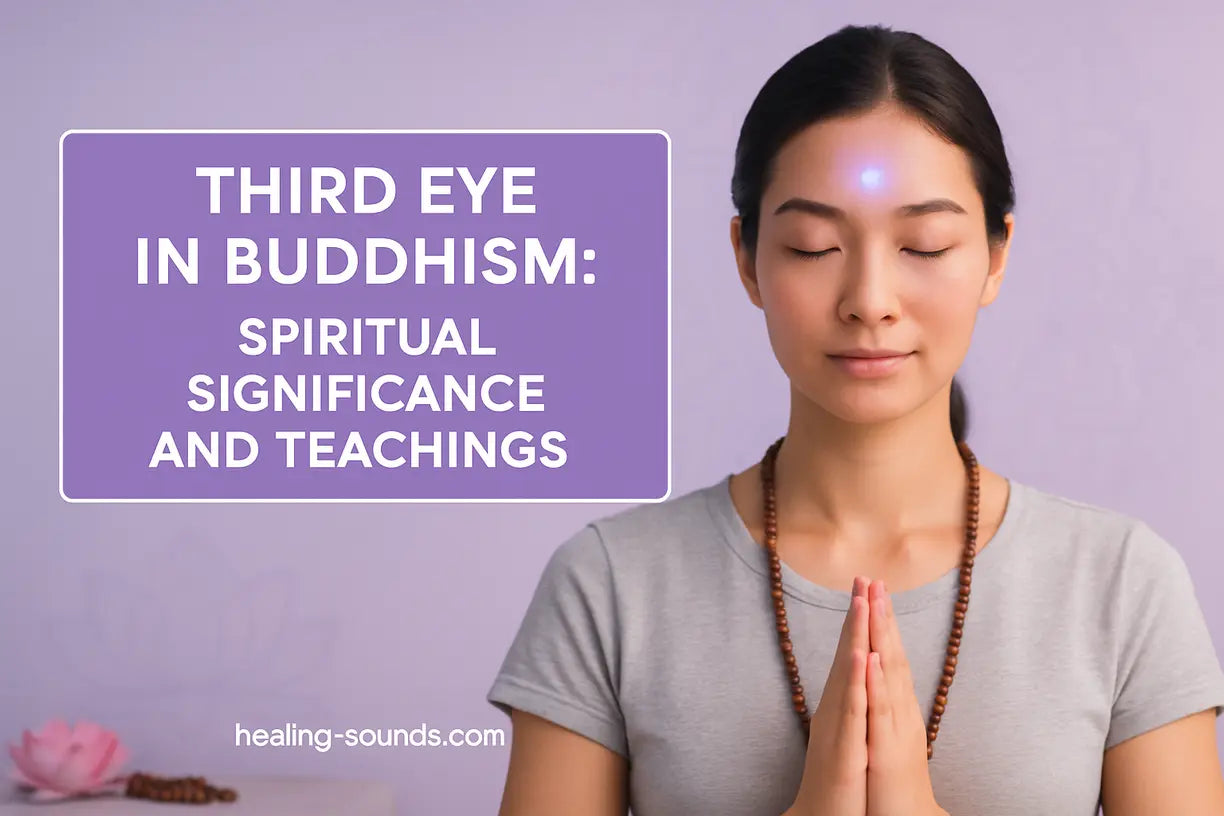Das Konzept des dritten Auges im Buddhismus spricht spirituell Interessierte und Achtsamkeitspraktiker gleichermaßen an und bietet ein tiefgründiges Symbol für innere Vision, Weisheit und das Potenzial zur Erleuchtung. Es ist weit mehr als nur eine mystische Vorstellung, es stellt einen zentralen Aspekt der buddhistischen Lehren über Bewusstsein und den Weg zu wahrem Verständnis dar. Wenn Sie tiefer in die buddhistische Weisheit eintauchen, die symbolische Bedeutung dieses spirituellen Auges entdecken und erfahren möchten, wie es mit Ihrem Weg zu größerem Bewusstsein zusammenhängt, ist diese Erkundung genau das Richtige für Sie. Sie werden die tiefe Bedeutung des dritten Auges im Buddhismus entdecken und wie seine Weisheit Ihre spirituelle Praxis erhellen kann.
Das dritte Auge in der buddhistischen Tradition verstehen
Im Buddhismus ist das „Dritte Auge“ kein physisches Organ, sondern eine kraftvolle Metapher für die Fähigkeit, über die gewöhnliche Wahrnehmung hinauszublicken und die wahre Natur der Realität zu erfassen. Es wird oft im Zusammenhang mit gesteigertem Bewusstsein, tiefer Einsicht (Prajna) und dem erwachten Zustand eines Buddha erwähnt. Das Verständnis seiner Symbolik ist entscheidend für das Verständnis seiner Rolle in der buddhistischen Philosophie und Praxis.
Die Urna: Mehr als nur ein Symbol
Vielleicht ist Ihnen auf Statuen und Darstellungen von Buddhas und Bodhisattvas schon einmal ein Punkt oder eine Haarlocke zwischen den Augenbrauen aufgefallen. Diese wird als Urna (ūrṇā-keśa) bezeichnet. Obwohl sie künstlerisch manchmal wie ein Auge dargestellt wird, ist die Urna traditionell eines der 32 wichtigsten körperlichen Merkmale (mahāpuruṣa lakṣaṇa) eines Buddha. Sie wird oft als weißes Haarbüschel beschrieben, das sich nach rechts kräuselt und Licht ausstrahlt. Symbolisch repräsentiert die Urna die tiefe spirituelle Einsicht Buddhas und die strahlende Weisheit, die allen Wesen den Weg erleuchtet. Sie symbolisiert die Kraft, die spirituelle Welt und die wahre Natur der Existenz wahrzunehmen und so die weltliche Sicht zu transzendieren.
Das Weisheitsauge (Prajnachakshu): Tor zum wahren Sehen
Direkter mit dem Konzept des „dritten Auges“ verwandt ist der Begriff Prajnachakshu , der oft als „Auge der Weisheit“ oder „Auge des Dharma“ übersetzt wird. Dabei handelt es sich nicht um ein physisches Zeichen, sondern um ein erwachtes Verständnisvermögen. Im Buddhismus bezeichnet das dritte Auge in diesem Sinne die Fähigkeit, Dinge nicht nur so zu sehen, wie sie an der Oberfläche erscheinen, sondern mit tiefer, durchdringender Weisheit. Es ist das Auge des Bewusstseins, das die Verbundenheit aller Phänomene, die Vergänglichkeit bedingter Dinge und den Pfad zur Befreiung vom Leiden wahrnimmt. Diese spirituelle Sicht wird durch ethisches Verhalten, meditative Konzentration und die Entwicklung von Weisheit kultiviert – die Kernlehren des buddhistischen Pfades.

Die spirituelle Bedeutung: Erwachen von Einsicht und Weisheit
Die spirituelle Bedeutung des dritten Auges in der buddhistischen Lehre ist immens. Es geht nicht nur um den Erwerb von Wissen, sondern um eine transformative Veränderung der Wahrnehmung, die zur Befreiung führt. Dieses innere Auge ist die Quelle wahrer Weisheit und Erkenntnis, unerlässlich für die Bewältigung der Komplexität des Lebens und die spirituelle Entwicklung.
Jenseits der gewöhnlichen Wahrnehmung: Die Rolle in der Erleuchtung
Die gewöhnliche Wahrnehmung, begrenzt durch unsere Sinne und unseren konditionierten Geist, führt oft zu Täuschung und Leid. Das dritte Auge, auch Weisheitsauge genannt, ermöglicht es, diese Schleier der Unwissenheit zu durchdringen. Es spielt eine entscheidende Rolle beim Erreichen der Erleuchtung (Bodhi), indem es dem Praktizierenden ermöglicht, Wahrheiten wie die Vier Edlen Wahrheiten und den Achtfachen Pfad direkt zu erfahren. Dieses „Sehen“ ist nicht intellektuell, sondern ein intuitives, erfahrungsbasiertes Verständnis, das das gesamte Wesen neu formt. Die Entwicklung dieser spirituellen Sicht ist gleichbedeutend mit der Reise zum Buddha – einem Erwachten.
Schlüsselaspekte des Dritten Auges im Buddhismus:
- Symbolisiert Prajna (transzendente Weisheit).
- Stellt die Fähigkeit dar, über das Physische hinaus die wahre Natur der Realität zu erkennen.
- Verbunden mit der Urna auf Buddha-Darstellungen.
- Kultiviert durch Meditation, ethisches Verhalten und Weisheit.
- Unverzichtbar für das Erreichen von Erleuchtung und Befreiung vom Leiden.
Die Realität so sehen, wie sie ist: Verbindung zu den zentralen Lehren des Buddhismus
Die Fähigkeit des dritten Auges, klar zu sehen, ist eng mit zentralen buddhistischen Lehren wie Pratītyasamutpāda (Bedingtes Entstehen) und Śūnyatā (Leere) verbunden. Bedingtes Entstehen erklärt, wie alle Phänomene in Abhängigkeit von anderen Ursachen und Bedingungen entstehen und betont die Verbundenheit. Leere bezeichnet den Mangel an inhärenter, unabhängiger Existenz aller Dinge. Die direkte Wahrnehmung dieser Wahrheiten durch das erwachte dritte Auge hilft, die Illusion eines festen, getrennten Selbst und das Streben nach Leid zu zerstreuen. Diese klare Sicht fördert Mitgefühl, Distanz und ein tiefes Gefühl des Friedens. Die Verbindung des dritten Auges ist entscheidend, um diese tiefgründigen philosophischen Konzepte erfahrungsmäßig zu verwirklichen.
Kultivierung der spirituellen Sicht: Buddhistische Praktiken
Während das dritte Auge einen Wachzustand symbolisiert, bieten buddhistische Traditionen praktische Methoden zur Kultivierung dieser inneren Vision. Dabei geht es nicht darum, eine esoterische Erfahrung zu erzwingen, sondern darum, den Geist schrittweise zu reinigen und durch anhaltende Anstrengung und ein ethisches Leben Klarheit zu entwickeln. Im Mittelpunkt dieser Kultivierung stehen Meditation und Achtsamkeit .
Praktiken wie Vipassanā (Einsicht) und Samatha (Ruhe) sind grundlegend. Vipassanā beinhaltet die Beobachtung der wahren Natur der Realität durch direkte Erfahrung, während Samatha tiefe Konzentration und geistige Ruhe entwickelt und so die Voraussetzungen für die Entstehung von Weisheit schafft. Achtsamkeit, die Praxis, dem gegenwärtigen Moment ohne Wertung Aufmerksamkeit zu schenken, hilft, das Bewusstsein zu schärfen und geistige Unordnung zu reduzieren, wodurch sich das „Auge der Weisheit“ auf natürliche Weise öffnet.
Alchemy – Klangschale aus klarem Indigo-Kristall „A Note“
$369.00 $469.00
Vertiefen Sie Ihre Meditationen zum dritten Auge mit dieser Klangschale aus Indigokristall, die perfekt auf die Stärkung der spirituellen Intuition abgestimmt ist.
Produkt entdecken
Die Entwicklung spiritueller Sicht wird oft durch die Betrachtung buddhistischer Schriften und Lehren, ethisches Verhalten (Sila) und die Entwicklung heilsamer Geisteszustände unterstützt. Unten sehen Sie ein Video, das Buddhas Weg zur Öffnung des dritten Auges aus praktischer Perspektive beleuchtet.
Die Entfaltung der inneren Vision erkennen
Wie erkennt man aus buddhistischer Sicht, ob die spirituelle Sicht, das „Dritte Auge“, aktiver oder offener wird? Anstatt dramatische psychische Phänomene zu erwarten, sind die Anzeichen oft subtiler und in den eigenen Charakter und das eigene Verständnis integriert. Eine sich entfaltende innere Vision im buddhistischen Kontext manifestiert sich oft wie folgt:
- Mehr Klarheit und Einsicht: Ein tieferes Verständnis der buddhistischen Lehren, nicht nur intellektuell, sondern auch auf intuitiver Ebene. Die vergängliche, unbefriedigende und selbstlose Natur bedingter Phänomene wird deutlicher erkannt.
- Größeres emotionales Gleichgewicht: Weniger Reaktivität gegenüber den Höhen und Tiefen des Lebens. Ein wachsendes Gefühl von innerem Frieden und Gleichmut.
- Mehr Mitgefühl und Güte: Natürliche Empathie für andere und der aufrichtige Wunsch nach ihrem Wohlergehen, der aus dem Verständnis der Verbundenheit entsteht.
- Reduzierte Anhaftung und Abneigung: Weniger Festhalten an angenehmen Erfahrungen und weniger Widerstand gegen unangenehme.
- Geschärfte Intuition: Ein verfeinertes Gefühl für inneres Wissen oder Führung, das mit ethischen Grundsätzen übereinstimmt.
Es ist wichtig, diesen Zeichen mit Demut zu begegnen und spirituellen Stolz zu vermeiden. Der Weg des dritten Auges im Buddhismus ist ein Weg der kontinuierlichen Entfaltung, geleitet von Weisheit und Mitgefühl. Wer sich tiefer mit Meditation beschäftigen möchte, findet auf Ressourcen wie LionsRoar.com wertvolle Einblicke in die Vipassanā-Meditation .
Die Weisheit des dritten Auges in das tägliche Leben integrieren
Der wahre Wert der Kultivierung des „Weisheitsauges“ liegt in seiner Anwendung im Alltag. Die gewonnenen Erkenntnisse sind nicht auf das Meditationskissen beschränkt, sondern sollen unsere Gedanken, Worte und Taten prägen. Die Integration dieser Weisheit bedeutet, bewusster, zielstrebiger und gütiger zu leben. Es bedeutet, herausfordernde Situationen klarer zu sehen und mit Weisheit statt Reaktivität zu reagieren. Es bedeutet auch, die Buddha-Natur – das Potenzial zur Erleuchtung – in sich selbst und anderen zu erkennen. Diese praktische Anwendung verwandelt spirituelle Praxis von einer isolierten Aktivität in eine Seinsweise.

Vorteile der Kultivierung des Weisheitsauges:
- Tieferes Selbstbewusstsein und Verständnis des eigenen Geistes.
- Weniger Stress und mehr emotionale Belastbarkeit.
- Stärkere Verbindung zu den eigenen spirituellen Werten.
- Verbesserte Beziehungen durch mehr Empathie und Mitgefühl.
- Ein sinnvolleres und zielgerichteteres Leben.
Der Weg zum Erwachen des göttlichen Auges, von dem der Buddhismus spricht, wird durch konsequente Praxis und oft durch die Schaffung einer förderlichen Umgebung für Kontemplation unterstützt. Das Verständnis zentraler Konzepte wie Prajna (Weisheit) in der buddhistischen Philosophie kann die Wertschätzung für diesen Weg ebenfalls vertiefen.
Hilfsmittel für Ihre kontemplative Reise
$299.90
$349.90
Entdecken Sie spirituelle Erkenntnisse mit Chakra-Röhren, einschließlich der Frequenz des dritten Auges – ideal für Energieheilung oder meditative Rituale. Mehr erfahren ➔
$24.90
$35.90
Tragen Sie dieses elegante Lapislazuli-Armband, um die Klarheit des dritten Auges, die spirituelle Konzentration und das meditative Gleichgewicht den ganzen Tag über zu unterstützen. Mehr erfahren ➔
Abschluss
Das dritte Auge ist im Buddhismus ein tiefgründiges Symbol, das den Höhepunkt spiritueller Erkenntnis, Weisheit und der direkten Wahrnehmung der Wahrheit darstellt, die zur Erleuchtung führt. Es ist das „Auge der Weisheit“ oder Prajnachakshu, das durch fleißige Meditationspraxis, ethisches Verhalten und das intensive Studium der buddhistischen Lehren kultiviert wird. Das Verständnis seiner Bedeutung bietet nicht nur intellektuelles Wissen, sondern auch einen Weg zur Transformation unseres Bewusstseins und zu einem Leben mit mehr Klarheit, Mitgefühl und Frieden. Durch die Auseinandersetzung mit diesen alten Lehren können wir beginnen, unsere eigene innere Vision zu nähren und den Weg zu tiefem spirituellem Erwachen zu beschreiten. Begeben Sie sich auf die Entdeckungsreise, und möge Ihre Praxis Sie dazu führen, mit dem klaren Auge der Weisheit zu sehen.
Häufig gestellte Fragen zum Dritten Auge im Buddhismus
Im Buddhismus bezieht sich der „dritte Blick“ auf Prajnachakshu , das „Auge der Weisheit“ oder „Auge des Dharma“. Es handelt sich nicht um ein physisches Auge, sondern um eine spirituelle Fähigkeit, die es ermöglicht, die wahre Natur der Realität jenseits oberflächlicher Erscheinungen zu erkennen. Diese Einsicht umfasst das Verständnis zentraler buddhistischer Wahrheiten wie Vergänglichkeit, Leiden, Nicht-Selbst und Leere, was zu Weisheit und Befreiung führt.
Das dritte Auge symbolisiert im Allgemeinen einen Zustand erleuchteter Wahrnehmung, Intuition und spiritueller Einsicht. Im buddhistischen Kontext repräsentiert es insbesondere das „Auge der Weisheit“ (Prajnachakshu), die Fähigkeit, über Illusionen hinauszublicken und die ultimative Wahrheit zu verstehen. Es symbolisiert das erwachte Bewusstsein, das die Realität so wahrnimmt, wie sie wirklich ist, was zu Erleuchtung und Freiheit von Leiden führt.
Das „geistige Auge“ im Buddhismus ist eng mit dem Konzept des Prajnachakshu oder Weisheitsauges verknüpft. Es bezeichnet die innere Fähigkeit zur Einsicht und zum Verständnis, die durch Praktiken wie Meditation und Achtsamkeit kultiviert wird. Es ist die Fähigkeit zur Selbstbeobachtung, zum klaren Verständnis des Dharma (buddhistische Lehren) und die Fähigkeit, Wahrheit von Täuschung zu unterscheiden, die für den spirituellen Fortschritt entscheidend ist.
Im buddhistischen Kontext geht es bei „Aktivierung“ nicht um plötzliche übersinnliche Kräfte, sondern um die allmähliche Entfaltung von Weisheit und Klarheit. Anzeichen dafür sind unter anderem ein besseres Verständnis der buddhistischen Lehren, größere emotionale Gelassenheit, gesteigertes Mitgefühl, weniger Anhaftung und Abneigung sowie ein intuitiveres Verständnis, das mit ethischem Verhalten im Einklang steht. Es geht weniger um Visionen als vielmehr um eine grundlegende Veränderung der Wahrnehmung und eine Vertiefung der spirituellen Einsicht .
Buddha-Darstellungen zeigen oft eine Urna , einen Haarbüschel oder einen Punkt zwischen den Augenbrauen, der Buddhas tiefe spirituelle Vision und Weisheit symbolisiert. Obwohl es sich nicht buchstäblich um ein drittes Auge handelt, stellt es das erwachte „Weisheitsauge“ (Prajnachakshu) dar und symbolisiert sein vollständiges Verständnis der wahren Natur der Realität und seine Fähigkeit, über das Alltägliche hinauszublicken. Es ist eines der Kennzeichen eines erleuchteten Wesens und weist darauf hin, dass die Bedeutung seines dritten Buddha-Auges mit Allwissenheit und spiritueller Autorität verbunden ist.







